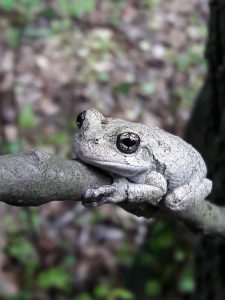Gray treefrog (Hyla versicolor): At Home in the Greenbelt
 Gray treefrog (Hyla versicolor) in High Rock Park, June, 2019
Gray treefrog (Hyla versicolor) in High Rock Park, June, 2019
Photo and article: Christopher Ricker
“Sound can be what you associate with a particular landscape” – Aldo Leopold
Come summer, the Greenbelt landscape is alive with the sounds of nature. Katydids, Cicadas, Warblers, Geese, angsty Blue Jays – and many more species – fill our forests and wetlands with a plethora of distinct and magical sounds.
One member of this Greenbelt choir is the Gray treefrog (Hyla versicolor), a species of small arboreal frog native to Staten Island. The Gray treefrog has large, sticky toe pads that enable it to cling to tree bark and shrubs. It measures 1.5 to 2 in (3.8 to 5.1 cm). The skin has a lumpy texture, which helps them to camouflage amongst the branches and trunks of trees.
Gray treefrogs breed in May. Clusters of up to 30 eggs are attached to vegetation near the surface of breeding ponds and vernal pools. Generally, these frogs use shallow wetlands within or near forested habitat for mating. The Greenbelt offers both, providing a perfect habitat for their sustainability. Adults reach maturity within two years.
One of NYC Parks’ success stories involves the Gray treefrog reintroduction to to the Greenbelt in 1998 as part of Project X. Under the direction of then Parks Commissioner, Henry J. Stern, Project X focused on bringing endangered species of flora and fauna back into New York City’s parks. The frog was initially reintroduced in the LaTourette Park section of our parkland. Since 1998 the Grey treefrog has reclaimed most of its former Staten Island habitat, which have been documented from Great Kills to Port Richmond.
Christopher Ricker is a member of the Greenbelt Environmental Education staff.
